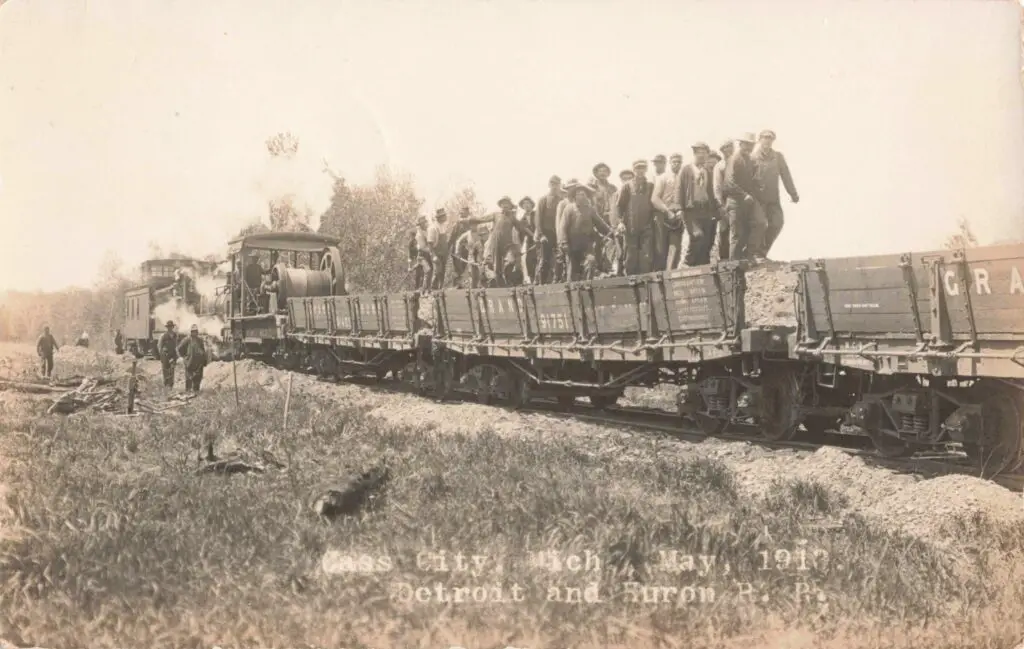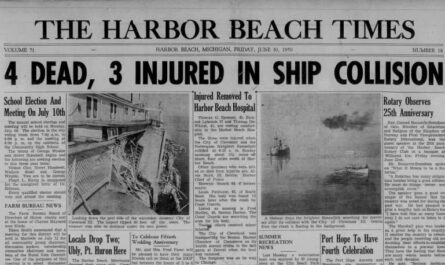Back in May 1913, the peaceful farming community of Cass City, Michigan, was buzzing with activity. The reason? Construction was underway on a new rail line, the Detroit and Huron Railroad (D&H), set to connect Cass City with Bad Axe, just 18 miles northeast. This rail line was a big deal for the people of Michigan’s Thumb, promising to provide farmers and merchants with a faster route to markets across the state and even further afield.
There’s even a video of the Cass City Rail Crew from 1913, showing the hustle and bustle of the time.
Building the Detroit and Huron Railroad Line was no small feat. Photos from May 1913 show teams of workers standing on open flatcars, with steam locomotives puffing away behind them. These men, armed with shovels and picks, worked tirelessly to move the earth, set the ties, and spike the rails into place. It was a combination of sweat, grit, and mechanical force that powered the expansion of the railroad.
Although the Detroit & Huron was incorporated in 1910, the serious construction work didn’t start until 1912. By September 28, 1913, trains were officially running the full length from Cass City to Bad Axe. This was a game-changer for Cass City, connecting it to the regional economy. Farmers could now transport livestock and grain more efficiently, and merchants had quicker access to manufactured goods arriving from Detroit.
Interestingly, the Detroit and Huron Railroad was controlled from the start by the Grand Trunk Western Railroad (GTW), a subsidiary of Canadian National. The D&H operated as a separate entity for about 15 years before being officially merged into GTW on November 1, 1928.
For most of its life, the Cass City–Bad Axe line was a sleepy branch route. It carried modest amounts of freight and offered mixed train service that sometimes combined freight cars with a passenger coach. It might not have been the most glamorous route, but it was steady, dependable, and crucial for rural communities.
However, by mid-century, the Thumb’s railroad network was overbuilt. The competing Pere Marquette Railway (later known as the Chesapeake & Ohio) also served Bad Axe, providing shippers with alternatives. As cars, trucks, and improved highways became more common, both passengers and freight started to shift away from rail.
On April 30, 1951, the Cass City–Bad Axe line saw its last scheduled train. Grand Trunk’s Pacific locomotive No. 5038 made the final run, marking the end of an era. After that, the line was abandoned and dismantled. Today, only faint traces of the Detroit & Huron can be seen across fields and in woodlots. But back in 1913, this line represented progress, a connection to broader markets, and a symbol of Michigan’s Thumb pushing forward into the modern age.
In short, the Detroit and Huron Railroad was a significant development for the people of Cass City and Michigan’s Thumb. It promised faster access to markets, boosted the regional economy, and marked a step forward into the modern age. However, with the advent of cars, trucks, and improved highways, the railroad eventually saw its last train in 1951 and was subsequently abandoned and dismantled. Yet, its legacy lives on, a reminder of a bygone era of grit, determination, and progress.
#MichiganHistory #RailroadLegacy
See the original post at [Rails Into the Thumb – Cass City and the Detroit and Huron Railroad, 1913- Video](https://thumbwind.com/2025/09/29/detroit-and-huron-railroad-1913/).
In May 1913, the quiet farming town of Cass City, Michigan, found itself in the midst of a significant transformation. Crews were hard at work constructing a new rail line that would link Cass City with Bad Axe, about 18 miles to the northeast. Known as the Detroit and Huron Railroad (D&H), this line promised to connect communities in Michigan’s Thumb, offering both farmers and merchants faster access to markets across the state and beyond.
Video – Cass City Rail Crew, 1913
Building the Detroit and Huron Railroad Line
Photographs from May 1913 show teams of laborers standing on open flatcars, with steam locomotives hissing behind them. Men armed with shovels and picks worked along the grade as the earth was moved, ties were set, and rails were spiked into place. In these scenes, we see the labor that powered railroad expansion: a mix of sweat, grit, and mechanical force.
The Detroit & Huron was incorporated in 1910, but construction pushed forward in earnest by 1912. By September 28, 1913, trains were officially running the full length from Cass City to Bad Axe. This opening marked a turning point, solidifying Cass City’s connection to the regional economy. Farmers could move livestock and grain more efficiently, while merchants had quicker access to manufactured goods arriving from Detroit.
Under the Grand Trunk

Although the line bore its own name, it was controlled from the beginning by Grand Trunk Western Railroad (GTW). This Canadian National subsidiary was aggressively expanding in Michigan during the early 20th century. The D&H operated as a separate entity for about 15 years before being formally merged into GTW on November 1, 1928.
For most of its life, the Cass City–Bad Axe line was a sleepy branch route, carrying modest amounts of freight and offering mixed train service that sometimes combined freight cars with a passenger coach. Unlike the bustling mainlines of the era, this was a rural lifeline — steady, dependable, but rarely glamorous.
Decline and the Last Train
By mid-century, the Thumb’s railroad network was overbuilt. The competing Pere Marquette Railway (later known as the Chesapeake & Ohio) also served Bad Axe, providing shippers with alternatives. Meanwhile, cars, trucks, and improved highways shifted both passengers and freight away from rail.
On April 30, 1951, the Cass City–Bad Axe line saw its last scheduled train. Grand Trunk’s Pacific locomotive No. 5038 made the final run, hauling about ten cars along the branch. A small combine car carried passengers, marking the end of an era. As reported by contemporary accounts, the train reached Bad Axe, then turned back toward Cass City, closing the book on nearly four decades of service.
Soon after, the line was abandoned and dismantled. Today, little remains of the Detroit & Huron but faint right-of-way traces across fields and in woodlots. Yet for Cass City in 1913, this line represented progress, a connection to broader markets, and a symbol of Michigan’s Thumb pushing forward into the modern age.
Works Cited
“Bad Axe Subdivision.” Abandoned Rails. AbandonedRails.com, 2010. https://www.abandonedrails.com/bad-axe-subdivision
“The Last GTW Train to Bad Axe.” Michigan Railroads. MichiganRailroads.com, 2023. https://www.michiganrailroads.com/stories/5290-the-last-gtw-train-to-bad-axe
“Detroit and Huron Railway Fonds.” Library and Archives Canada. Government of Canada, 2016. https://recherche-collection-search.bac-lac.gc.ca/eng/home/record?IdNumber=162684&app=fonandcol








